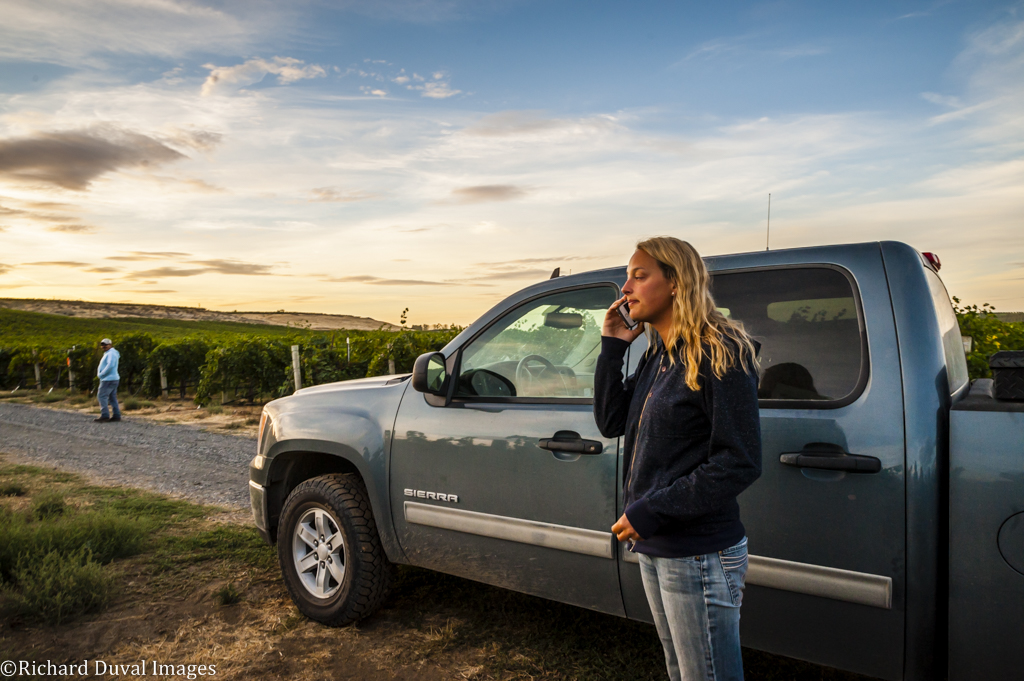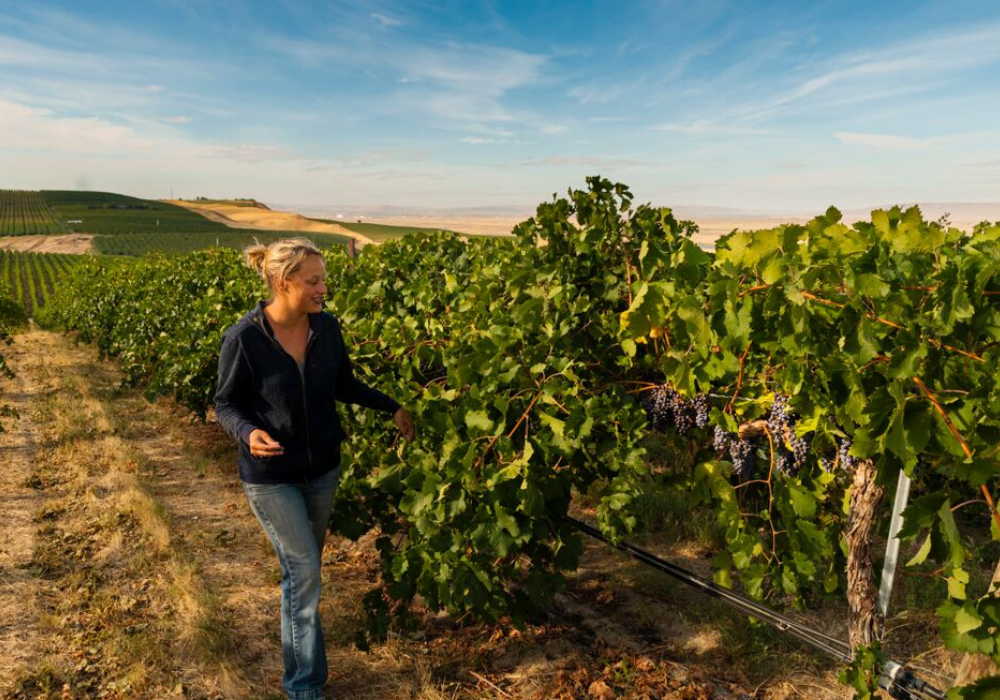“Es divertido ver el terruño con nuestros propios ojos.”
Meet Lacey Lybeck, Vineyard Manager at Sagemoor Vineyards in the White Bluffs AVA, where she oversees six different vineyards. Growing up on a family farm in La Conner, WA, in the Skagit Valley, Lacey jokes that in high school, her job was sorting daffodils from dirt clods. This to say: she was excited to graduate, and finally pursue that dream of agriculture. A short talk with Lacey, and you can hear the passion, joy, and wisdom. “It’s just so fun to be able to tell the story of how we manage, curate, and work with each winemaker’s row as they come in, see their area, and get to know their fruit. You have to take every year for its own. Nature is going to throw its own challenges at you, but it’s also going to throw its own opportunities and benefits. Sometimes, those are very closely linked together.”
I just love being able to identify problems before they happen.—Lacey Lybeck, Sagemoor Vineyards
Translated by Rosanna Lugo
Washington Wine: Drop us in to a day in the life of Lacey.
Lacey Lybeck: I’m the vineyard operations manager with Sagemoor Vineyards. Sagemoor is comprised of six vineyards throughout the White Bluffs AVA. I get to work with a ranch manager at each site who executes our day-to-day plan, as well as our spray program, pruning, and working day to day with the branch managers. I love working directly with our customer base. We sell wine grapes to over 120 different wineries in Washington state.
It’s just so fun to be able to tell the story of how we manage, curate, and work with each individual’s row as they come in, see their area, and get to know their fruit. Having conversations with winemakers about the wines that they’re hoping to produce and finding a vineyard source that fits their vision is so rewarding. Each vineyard is so unique. It’s fun to pair the perfect block with the right winemaker.
WW: Tell me about the scale of this: working with 120 different wineries.
Lacey: It’s really unique, and relationship by relationship. There are some winemakers who are visiting us regularly throughout the season, weekly tasting fruit. We get to work with some people over in Woodinville who aren’t as able to freely drive over the Cascades and make the trip over here, so get to describe what we’re tasting out in the vineyard and how the flavors will change over the next week or two, or describe the conditions in the vineyard to the winemaker without making a picking decision for them. Really just providing them with all the tools to see if that sounds like their house style. It’s just so fun to be able to get to know people from all over Washington State, Oregon, and the Pacific Northwest through their winemaking programs. Everybody’s got such a unique style of what wine they want to produce, that it’s fun to have different vineyards to offer.
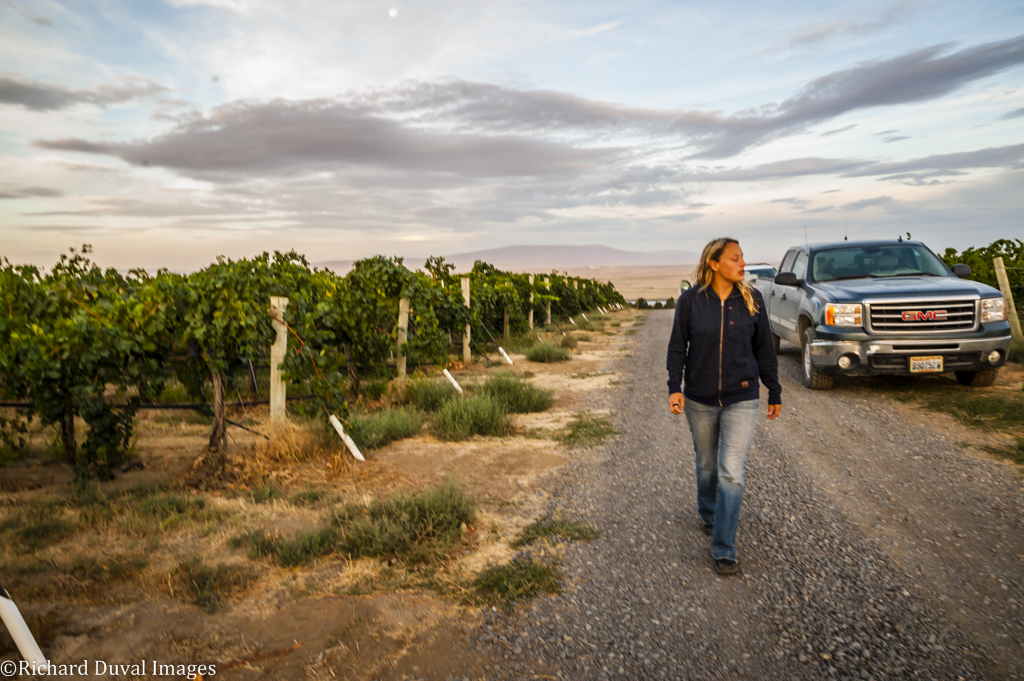
WW: What a human experience.
Lacey: What’s fun is that our team members know each winemaker and their style so well that we’ll make adjustments in the field and on the go. For example, Bookwalter loves a big ripe style Cabernet, so we’ll do a little extra leaf exposure in cooler years.
WW: For someone who’s never been to Sagemoor Vineyards, how would you describe the scenery and where y’all are situated?
Lacey: We are perched on White Bluffs overlooking the Columbia River. We’ve got beautiful elevation from 600 to 900 feet with the river below us, and so we’ve got excellent air drainage during the spring time, as well as during harvest. We’ve got very sandy, windblown soils. I just love the vision of our Old Vine Cabernet vines. These old vines are six inches plus in diameter. They’ve never been cut down to the ground and they are still producing wines for over 30 different wineries in the state.
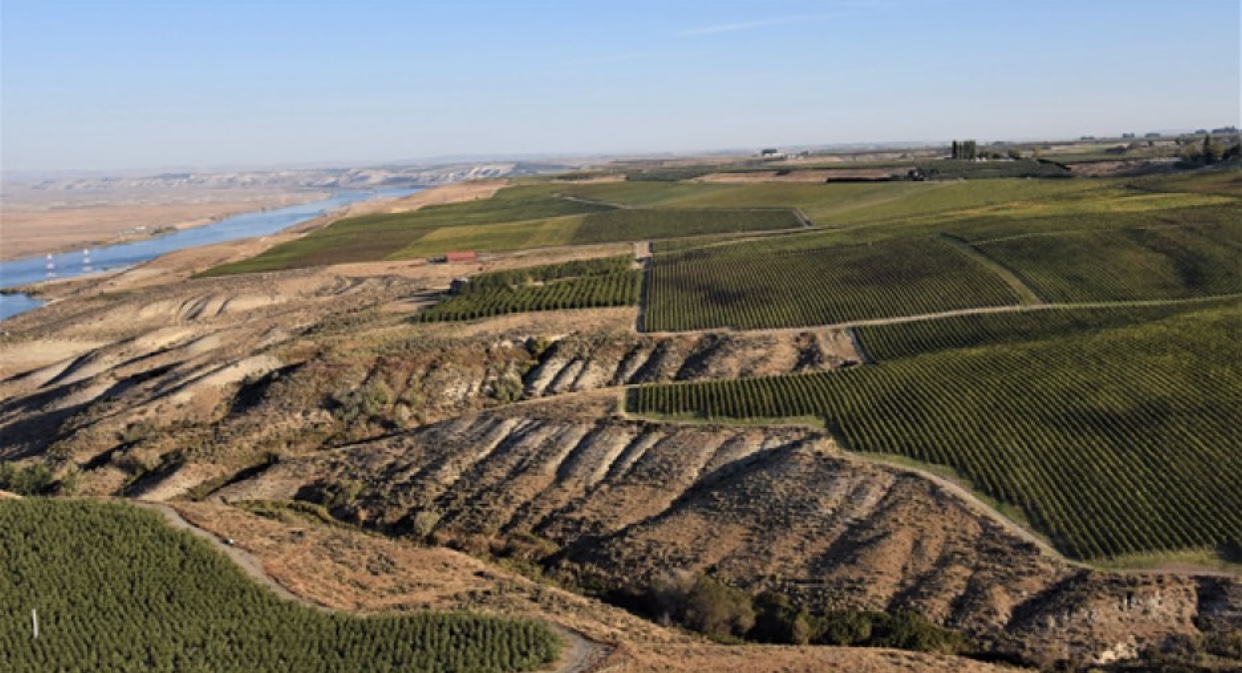
WW: With White Bluffs now being its own AVA, how big of a deal is that for y’all out there?
Lacey: It was so exciting. It’s an area that we’ve always known is very special and the winemakers that we work with describe the fruit as being very unique to this area. Soft, plush, approachable reds, that still have tannin to them, and structure and very expressive and floral white varieties like Sauvignon Blanc, Semillon and Chardonnay. It’s so cool to be able to take that flavor profile that this area so uniquely provides and put it on the map. Give it a name, White Bluffs. It’s fun to see terroir with our own eyes.
It’s fun to see terroir with our own eyes.
WW: What was your journey like into wine? Were you always in agriculture? When did that start?
Lacey: I grew up on a family farm in La Conner, Washington, so up north in the Skagit valley. I joke that in high school, my job was sorting daffodils from dirt clods. I was eager to get to WSU and learn more about agriculture. I loved the connection of the earth and the seasons to what you’re doing. In an entry-level crops class, they introduced a vineyard manager for a week on viticulture and wine grapes. I was fascinated by the experience of being able to capture each vintage and have a different flavor profile representative of the year rather than growing for homogeny.
I began taking as many viticulture technology classes as were offered. I took an opportunity to study abroad in the south of France, which was just a summer introductory agriculture program that brought me on to a family farm for a month in the south of France. I got to remove suckers from the trunk and bottling and all sorts of different activities, which was fun. I then graduated in December 2010.
I did an internship with Ste. Michelle and really enjoyed it. I knew my heart was in viticulture. I thought that a great way to know how to solve a winery’s problems or to know the whole system from the front to back would be the best way to know how to deliver the best customer service. I went to New Zealand and worked at a winery for six weeks. It was a big custom crush facility, and we would have anything from truckloads of Pinot Noir to sorting hand-picked fruit that had traveled from all over the north island. Getting to see what happens when you have defect fruit or something not desirable on the sorting table and how taking that out in the field and not putting that in the bin just prevents so many problems at the bottleneck of getting the fruit in the winery. I loved my experience down there.
I made a jump to Welch Wine Company for a short period of time and worked with growers all over Washington state sourcing for their different wine programs they ferment for. And Sagemoor was one of those growers. After really enjoying the high-tier viticulture that Sagemoor offers, I joined the team in 2015.
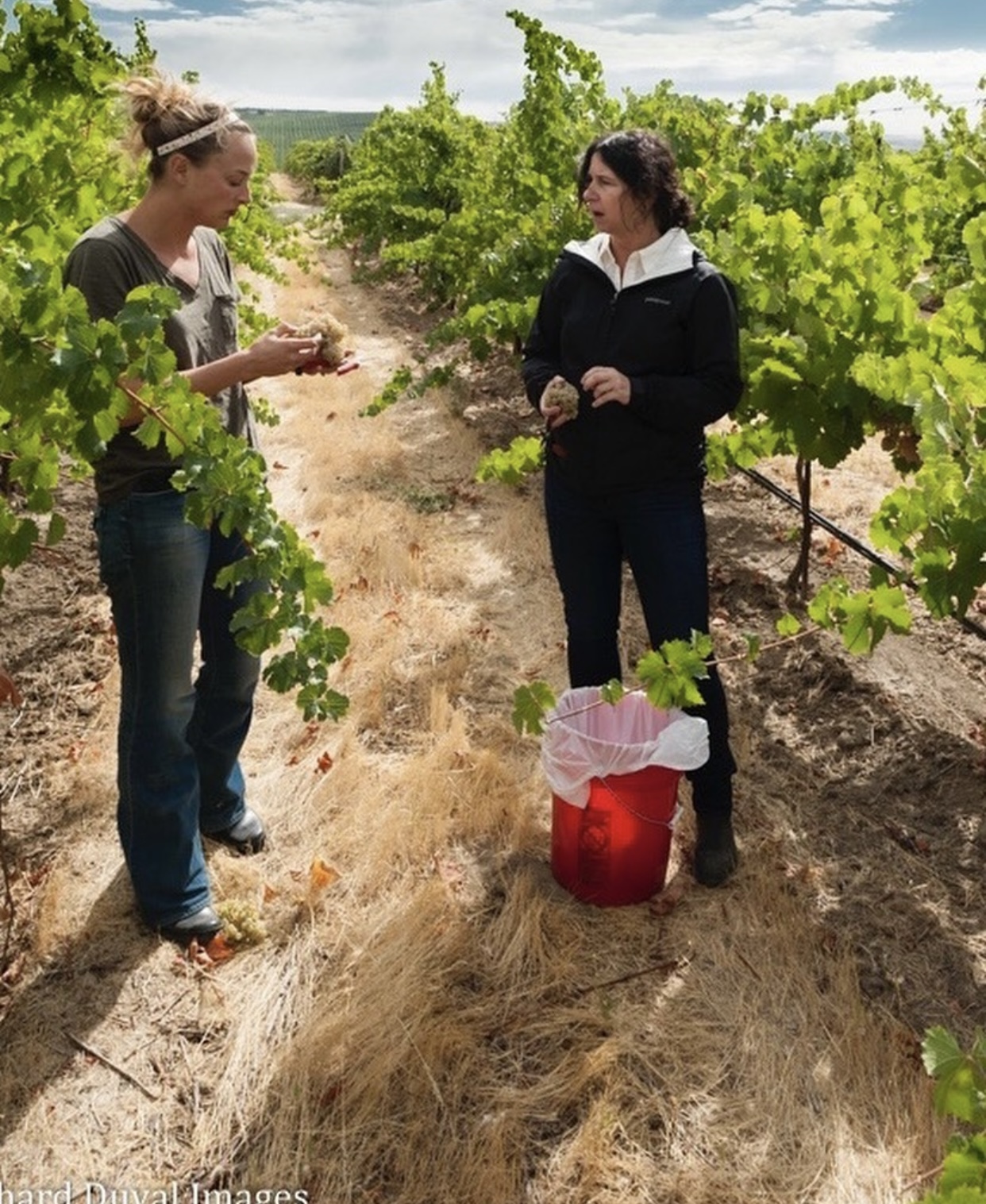
WW: You’ve been there for six years now. Is every year just dramatically different?
Lacey: I feel like you have to take every year for its own. Nature is going to throw its own challenges at you, but it’s also going to throw its own opportunities and benefits. Sometimes, those are very closely linked together.
This year was one where we were just very dry, and so realizing we don’t have the moisture in the soil that we normally do, we had to adjust early and start irrigating early, which I think every vineyard manager in Washington State would tell you. We like to use the water that’s in the soil profile and wait as long as we can to turn on the water. But this year there was not water available.
It keeps you on your toes: you have to wait and see what the vines are telling you for this year, because there were ways that we could read the vine and know that there was water stress going on. But on the other side, this year was a year where we identified that we’ve got about three tons per acre in Cabernet from the very beginning. And so a challenge on crop load. We’d love to have a little more crop as a buffer, but that concentration is going to have been on the vine from the start of the season. And I’m really excited for the quality of our Cabernet.
You have to wait and see what the vines are telling you for this year.
WW: Right now, it’s July 2021. What do you like about this time of year?
Lacey: I love this time of the year, because we’re really getting ready for harvest. I love to take it as a time to really reconnect with all of our winemakers and customers prior to harvest. Also, to really ensure that we’re building a solid foundation with our laboratory and our grape sampling, because that’s key to report to customers, as well as ensuring that our team members who will have a very busy time during harvest get a little time off. It all takes time. We ran some Sauvignon Blanc yesterday and the brix were above 15. We’ll pick around 21, but I was surprised to see that we were at that rank.
WW: What keeps you going through the busy times?
Lacey: I am really pretty solid about self-care, which is a term that’s overused, but scheduling time to go to yoga, for example. Also, I’ve got a two-year old now, so I’ve got to go pick Connor up from daycare. For myself to be completely honest, I think also building a strong team and having those people that you can rely on when things get challenging and the days get long is key.
That’s what’s exciting, you all of a sudden will look at your watch and it’s way later in the day than you anticipated. It’s important to identify problems before they happen and then think of creative ways to kind of prevent or solve things. Harvest gives you so many opportunities to either be in communication about things that are getting close to being ripe and starting to kind of share what the vineyard is looking like, to just having that fun being on your toes. You never know what the day is going to bring. You have a schedule. You have what you’re going to pick and it’s always exciting.

WW: You mentioned Connor. Has he seen the vines yet?
Lacey: He loves tractors and seeing anybody with an engine. Anytime he’s out there, he gets mesmerized by watching the tractors go. He’ll walk around and definitely loves tasting the grapes once they get ripe.
WW: That’s the age-appropriate way to do it. Taste the grapes now, and the wine in 19 years.
Lacey: Exactly.
WW: Outside of Vineyard Manager and mother, how else do you split your time?
Lacey: For the past two seasons, in the downtime of January and February, I’ve been fortunate enough to be an adjunct professor with Washington State University. I’ve gotten to teach the Capstone Viticultural Terminology class with Dr. Tom Collins, and really getting to know the graduating seniors as they work through receiving a vineyard and putting together a vineyard management plan.
WW: So it goes full circle, then.
Lacey: It always does.
WW: Time for some random questions. What is your favorite non-musical sound?
Lacey: Non-musical sounds?
WW: Yep.
Lacey: The rustling of leaves. Gosh, that’s hard. A singing bull? That’s kind of weird.
WW: You win. What a great answer. How about things you do outside of wine and your fam? What else keeps you going?
Lacey: I’ve got a fun garden that my brother and I partner on. We’ve actually canned, let’s see, over 72 quarts of pickles already this year. It’s kind of funny. My family, growing up in Skagit Valley, grew cucumbers. And so we have Mrs. Nellie’s recipe passed down from the family. We love getting together. We made pickles last weekend, melons and cantaloupe and corn and tomatoes and get to eat it paired with wonderful Washington wines all summer long. It’s fun to just get to see that terroir with our own eyes.
WW: What would be one of your favorite parts of your job? Is it driving tractors? Is it seeing sunrises? Is it having a glass of wine at the end of the day?
Lacey: When the fruit is perfectly in the bin, just like the winemaker requested it, and it’s strapped down to the truck and you’re waving goodbye. You know that it’s just going to make excellent wine and you’ve done your part to set up just an amazing vintage. I think that’s one of the most satisfying moments where you just know you’ve put everything to get the best fruit in the bin and you’ve accomplished that. We get to do it over and over again every day for 60 days. And you got to keep that as your guiding light, because man, it makes every bin so important.
When the fruit is perfect in the bin, just like winemaker requested it, and it’s strapped down to the truck and you’re waving goodbye. That’s the most satisfying moment.—Lacey Lybeck
Traducido por Rosanna Lugo
Washington Wine: Cuéntanos un día en la vida de Lacey.
Lacey Lybeck: Soy el gerente de operaciones de viñedos de Sagemoor Vineyards. Sagemoor se compone de seis viñedos a lo largo de White Bluffs AVA. Me pongo a trabajar con un gerente de rancho en cada sitio donde se ejecuta nuestro plan diario, así como nuestro programa de fumigación, poda y trabajo diario con los gerentes. Me encanta trabajar directamente con nuestra base de clientes. Vendemos uvas para vino a más de 120 bodegas diferentes en el estado de Washington.
Es muy divertido poder contar la historia de cómo hemos gestionado, curado y trabajado con la fila de cada individuo a medida que entran, ven su área y conocen su fruta. Tener conversaciones con enólogos sobre los vinos que esperan producir y encontrar una fuente de viñedo que se ajuste a su visión es muy gratificante. Cada viñedo es tan único. Es divertido emparejar el bloque perfecto con el enólogo adecuado.
WW: Háblame de la escala de esto: trabajar con 120 bodegas diferentes.
Lacey: Es realmente único, y relación por relación. Hay algunos enólogos que nos visitan regularmente durante toda la temporada, probando frutas semanalmente. Trabajamos con algunas personas en Woodinville que no pueden conducir libremente sobre las Cascadas y hacer el viaje hasta aquí, así que describa lo que estamos probando en el viñedo y cómo cambiarán los sabores a lo largo de la próxima semana o dos, o describir las condiciones en el viñedo al enólogo sin tomar una decisión de selección por ellos.
Realmente solo brindándoles todas las herramientas para ver si eso suena como el estilo de su casa. Es muy divertido poder conocer gente de todo el estado de Washington, Oregón y el noroeste del Pacífico a través de sus programas de vinificación. Todos tienen un estilo único de qué vino quieren producir, que es divertido tener diferentes viñedos para ofrecer.

WW: Qué experiencia humana.
Lacey: Lo divertido es que los miembros de nuestro equipo conocen tan bien a cada enólogo y su estilo que haremos ajustes en el campo y sobre la marcha. Por ejemplo, a Bookwalter le encantan los Cabernet grandes y maduros, por lo que haremos un poco más de exposición a las hojas en los años más fríos.
WW: Para alguien que nunca ha estado en Sagemoor Vineyards, ¿cómo describiría el paisaje y dónde se encuentran?
Lacey: Estamos ubicados en White Bluffs con vista al río Columbia. Tenemos una hermosa elevación de 600 a 900 pies con el río debajo de nosotros, por lo que tenemos un excelente drenaje de aire durante la primavera, así como durante la cosecha. Tenemos suelos muy arenosos, arrastrados por el viento. Me encanta la visión de nuestras vides viejas de Cabernet. Estas vides viejas tienen más de seis pulgadas de diámetro. Nunca han sido cortados hasta el suelo y todavía están produciendo vinos para más de 30 bodegas diferentes en el estado.

WW: También es una gran noticia, ya que White Bluffs ahora es su propio AVA. ¿Qué tan importante es eso para todos ustedes?
Lacey: Fue tan emocionante. Es un área que siempre hemos sabido que es muy especial y los enólogos con los que trabajamos describen la fruta como algo muy exclusivo de esta área. Tintos suaves, afelpados, accesibles, que conservan el tanino, y estructura y variedades blancas florales, expresivas como el sauvignon blanc, semillón y chardonnay. Es genial poder tomar ese perfil de sabor que esta área proporciona de manera tan única y ponerlo en el mapa. Dale un nombre, White Bluffs. Es divertido ver el terruño con nuestros propios ojos.
Es divertido ver el terruño con nuestros propios ojos.
WW: ¿Cómo fue tu camino hacia el vino? ¿Siempre estuviste en la agricultura? ¿Cuándo empezó eso?
Lacey: Crecí en una granja familiar en La Conner, Washington, al norte del valle de Skagit. Bromeo que, en la escuela secundaria, mi trabajo consistía en separar los narcisos de los terrones de tierra. Estaba ansioso por llegar a WSU y aprender más sobre agricultura.
Me encantó la conexión de la tierra y las estaciones con lo que estás haciendo. En una clase de cultivos de nivel de entrada, presentaron a un gerente de viñedos durante una semana sobre viticultura y uvas para vino. Me fascinó la experiencia de poder capturar cada añada y tener un perfil de sabor diferente representativo del año en lugar de crecer para lograr la homogenidad como lo hacen otros cultivos.
Empecé a tomar todas las clases de tecnología vitivinícola que se ofrecían. Aproveché la oportunidad de estudiar en el extranjero en el sur de Francia, que fue solo un programa introductorio de agricultura de verano que me llevó a una granja familiar durante un mes en el sur de Francia. Tuve que quitar retoños del maletero y embotellar y todo tipo de actividades diferentes, lo cual fue divertido. Luego me gradué en diciembre, pero no había trabajos agrícolas realmente contratando en ese momento. Eso fue en diciembre de 2010.
Es un poco divertido: mis primeros dos años en el estado de Washington, no creo que llego a cien aquí en el este de Washington. Viví unas primeras temporadas muy suaves. Pero después de graduarme, ya había hecho un trabajo de interno con Ste. Michelle y realmente lo disfruté. Sabía que mi corazón estaba en la viticultura. Pensé que una excelente manera de saber cómo resolver los problemas de una bodega o conocer todo el sistema de adelante hacia atrás sería la mejor manera de saber cómo brindar el mejor servicio al cliente. Fui a Nueva Zelanda y trabajé en una bodega durante seis semanas.
Era una gran instalación de trituración personalizada, y teníamos de todo, desde camiones cargados de Pinot Noir hasta clasificación de frutas recolectadas a mano que habían viajado desde toda la isla norte. Llegar a ver qué sucede cuando tiene fruta defectuosa o algo no deseable en la mesa de selección y cómo sacarla en el campo y no ponerla en la mesa de sorteo y así evitar tantos problemas en el cuello de botella de obtener la fruta en la bodega. Me encantó mi experiencia allí.
Di un salto a Welch Wine Company por un corto período de tiempo y trabajé con productores de todo el estado de Washington para sus diferentes programas de vino para los que fermentan. Y Sagemoor era uno de esos cultivadores. Después de disfrutar mucho de la viticultura de alto nivel que ofrece Sagemoor, me uní al equipo en 2015.

WW: Has estado allí durante seis años. ¿Cada año es dramáticamente diferente?
Lacey: Siento que tienes que tomar cada año por su cuenta. La naturaleza te presenta sus propios desafíos, pero también oportunidades y beneficios. A veces, esos están muy estrechamente vinculados entre sí.
Este año fue uno en el que estuvimos muy secos, y al darnos cuenta de que no tenemos la humedad en el suelo que normalmente tenemos, tuvimos que ajustarnos temprano y comenzar a regar temprano, lo que creo que todos los gerentes de viñedos en el estado de Washington dirían. Nos gusta usar el agua que está en el perfil del suelo y esperar tanto como podamos para abrir el agua. Pero este año no había agua disponible.
Te mantiene alerta: tienes que esperar y ver qué te dicen las vides para este año, porque había formas en que podíamos leer la planta de uva y saber que había estrés hídrico.
Pero, por otro lado, este año fue un año en el que identificamos que tenemos alrededor de tres toneladas por acre en Cabernet desde el principio. Y así, un desafío en la carga de cultivo. Nos encantaría tener un poco más de cosecha como amortiguador, pero esa concentración habrá estado en la vid desde el comienzo de la temporada. Y estoy muy emocionado por la calidad de nuestro Cabernet.
Tienes que esperar y ver qué te dicen las vides para este año.
WW: Cuando esto se publique, estaremos mucho más allá de julio de 2021, pero ¿cómo encontrar normalmente esta época del año?
Lacey: Me encanta esta época del año, porque realmente nos estamos preparando para la cosecha. Me encanta tomarlo como un momento para reconectarme realmente con todos nuestros enólogos y clientes antes de la cosecha. Además, para garantizar realmente que estamos construyendo una base sólida con nuestro laboratorio y nuestro muestreo de uva, porque eso es clave para informar a los clientes, así como para garantizar que los miembros de nuestro equipo, que tendrán un tiempo muy ocupado durante la cosecha, obtengan un poco de tiempo de descanso. Todo lleva tiempo.
Probamos un poco de Sauvignon Blanc ayer y los ladrillos estaban por encima de 15. Recogeremos alrededor de 21, pero me sorprendió ver que estábamos en ese rango.
WW: ¿Qué te mantiene atravesando los tiempos ocupados?
Lacey: Soy bastante sólido sobre el cuidado personal, que es un término que se usa en exceso, pero programando tiempo para ir a yoga, por ejemplo. Para ser completamente honesto, creo que también es clave construir un equipo fuerte y tener a esas personas en las que puedes confiar cuando las cosas se ponen difíciles y los días se hacen largos.
Eso es lo emocionante, de repente miras tu reloj y es mucho más tarde de lo que esperabas. Ahora tengo un hijo de dos años, así que tengo que ir a recoger Connor a la guardería. Me encanta poder identificar los problemas antes de que sucedan y luego pensar en formas creativas de prevenir o resolver las cosas. La cosecha te brinda tantas oportunidades para estar en comunicación sobre cosas que están a punto de madurar y comenzar a compartir cómo se ve el viñedo o simplemente divertirte estando alerta.
Nunca se sabe lo que va a traer el día. Tienes un horario. Tienes lo que vas a elegir y siempre es emocionante.

WW: Mencionaste a Connor. ¿Ha visto ya las plantas de uvas?
Lacey: Le encantan los tractores y ver a alguien con un motor. Cada vez que está por ahí, se fascina al ver los tractores en marcha. Camina y definitivamente le encanta probar las uvas una vez que estén maduras.
WW: Esa es la forma apropiada para la edad de hacerlo. Pruebe las uvas ahora y el vino dentro de 19 años.
Lacey: Exactamente.
WW: Aparte de Gerente de Viñedo y madre, ¿de qué otra forma divides tu tiempo?
Lacey: Durante las últimas dos temporadas, en el tiempo de inactividad de enero y febrero, he tenido la suerte de ser profesor adjunto en la Universidad Estatal de Washington. He llegado a enseñar la clase de terminología vitivinícola de Capstone con el Dr. Tom Collins, y realmente he llegado a conocer a los estudiantes de último año que se gradúan mientras trabajan para recibir un viñedo y armar un plan de manejo del viñedo.
WW: Entonces se completa el círculo, entonces.
Lacey: Siempre lo hace.
WW: Hablando de círculos, estamos cerca de nuestro final de hoy, pero un par de preguntas aleatorias. ¿Cuál es tu sonido no musical favorito?
Lacey: ¿Sonidos no musicales?
WW: Si.
Lacey: El susurro de las hojas. Dios, eso es difícil. ¿Un toro cantor? Eso es un poco extraño.
WW: Tú ganas. Qué gran respuesta. ¿Qué hay de las cosas que haces fuera del vino y tu familia? ¿Qué más te mantiene en marcha?
Lacey: Tengo un jardín divertido en el que mi hermano y yo somos socios. De hecho, hemos enlatado, veamos, más de 72 cuartos de galón de pepinillos ya este año. Es un poco divertido. Mi familia, que creció en Skagit Valley, cultivaba pepinos. Y así tenemos la receta de la Sra. Nellie heredada de familia. Nos encanta juntarnos. Hicimos encurtidos el fin de semana pasado, melones y melón y maíz y tomates y podemos comerlos combinados con maravillosos vinos de Washington durante todo el verano. Es divertido poder ver ese terruño con nuestros propios ojos.
WW: ¿Cuál sería una de tus partes favoritas de tu trabajo? ¿Es conducir tractores? ¿Es ver amaneceres? ¿Es tomar una copa de vino al final del día?
Lacey: Cuando la fruta está perfectamente en las cajas, tal como la solicitó el enólogo y está amarrada al camión y te estás despidiendo. Sabes que se va a hacer un vino excelente y has hecho tu parte para preparar una cosecha increíble. Creo que ese es uno de los momentos más satisfactorios en los que simplemente sabes que has puesto todo para obtener la mejor fruta en el contenedor y lo has logrado. Podemos hacerlo una y otra vez todos los días durante 60 días. Y tienes que mantener eso como tu luz de guía, porque hombre, hace que cada contenedor sea tan importante.
Cuando la fruta está perfectamente en las cajas, tal como la solicitó el enólogo y está amarrada al camión y te estás despidiendo. Creo que ese es uno de los momentos más satisfactorios.
